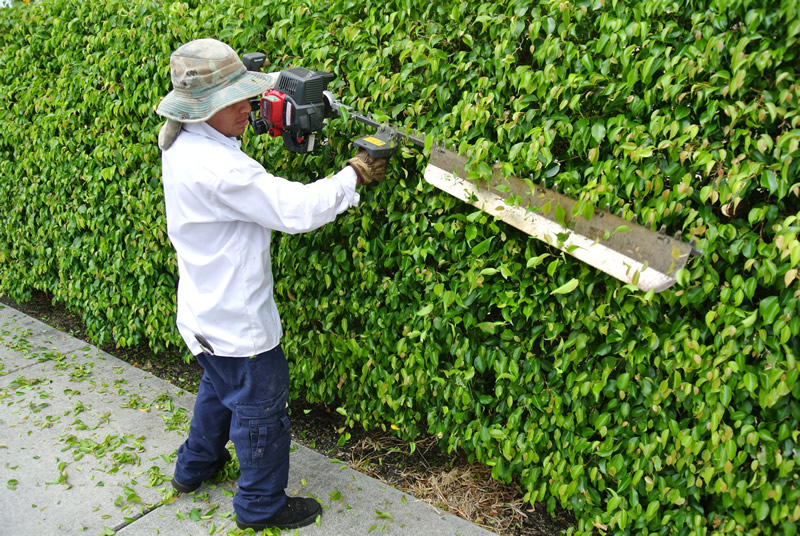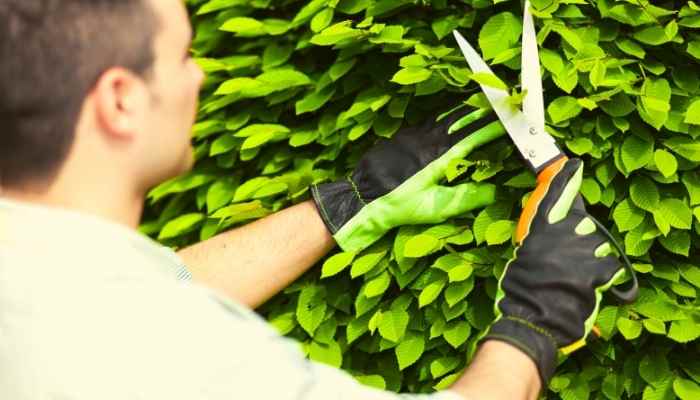Keeping your hedge in shape is not much daunting task. There are a few things that you need to get right and a few mistakes that you have to avoid.
To have a beautiful looking healthy hedge, here are a few things that you should be doing. I’ll also talk about a few mistakes that can ruin your efforts and how to avoid them.
Let’s Get into How To Keep your Hedges in Shape.
How to Shape Your Hedges?
We have compiled here some actionable tips to follow for keeping your hedges eye-catchy.
01. Choose the Right Plants
First things first, you’ve got to choose those plants to grow a hedge that responds well to being raised as a hedge. These plants could be evergreen or deciduous, conifers, or broad-leaf. The common thing about them is they fill out in response to heading cuts.
The plants that are suitable for hedging is supposed to be noted as “topiaries” or “hedging plants” on their plant labels. Make sure you’re choosing to hedge with such plants. Otherwise, all your efforts will go in vain, and no matter what you do, you won’t get the desired shape and health from your hedge.
Some popular considerations are – yew (Taxus), Euonymous, holly (Ilex), juniper (Juniperus), barberry (Berberis), quince (Cydonia oblonga), boxwood (Buxus), privet (Ligustrum), cedar (Cedrus), laurel (Laurus nobilis), Arborvitae, Pyracantha, and Viburnum.
02. Consider the Height & Preserve Boundaries
You need to consider how high you want to and ‘are permitted to’ keep your hedges. Tall & unmaintained hedges have become a cause for many a dispute. So if you’ve got neighbors, then you should keep your hedges below two meters to comply with the high hedge legislation that was a part of the Anti-Social Behaviour Act 2003: Part 8.
Also, you need to be concerned about the boundaries and make sure there are no overgrown hedges that border pathways or roads, which might cause danger to the public.
For this reason, I suggest that you allow more space than you need to near public pathways and set your boundary accordingly. This way, even if some of your hedges overgrow, they won’t immediately come across the pathways thanks to the extra space you allowed.
03. Start Them, Young
It’s just like teaching your kids how to act in the early stage of their life. The things you’ll teach them are likely to form their character and behavior in the latter part.
The same goes for the plants for hedges. Plants that you train from a very young age make for the best shaped and healthy hedge. In a beginning couple of years, the plants will be cut back six to eight inches, which will encourage and teach them to branch close to the core of the plant.
In the third year, you can start shaping the hedge, which will help to determine the structure of it as it grows to its final and mature size. You need to shape the hedge until after the plants have grown to their full size, as otherwise, there will be a lack of branches at the base, and a full hedge won’t be created.
After the hedge has reached the size and shape that you like it to be, trimming it frequently is the best way to keep the look.
04. When to Prune?
The general rule of thumb here is to prune the hedge before the lower leaves deprive sunlight caused by the new growth. If the lower leaves do not get enough sunlight, they’ll soon die off.
Some evergreen plants tend to grow quickly, and you’ll have to prune them every four to six weeks in the growing season. While other plants grow a bit slower, it’ll be enough if you prune them only once in a few months. So the required frequency of pruning will be determined by what plants you’ve chosen.
However, the way you can make it simple is just by watching the growth. Whenever the lower leaves are about to be deprived of sunlight, prune the new growth.
Another thing to keep in concern is which month you’re choosing to trim. The end of August is a great time to trim, But doing it in the spring or summer can be harmful to birds and wildlife.
The RSPB also recommends not to use a hedge trimmer between March and August, and that’s the time when the main breeding season for nesting birds occurs. Also, when you’re set to trim, you should check for any nest or other wildlife living in the hedges.
Considering the two factors can be conflicting with each other, I know. You just have to find the sweet spot between them by sacrificing a little from one or both ends.
05. Hedge Pruning Tools
Next, you have to choose the right set of tools to help you with the trimming and pruning job. Many recommend electric while others prefers hand ones. I say making a sweet combination is the best way to go.
See both the automatic and hand tools have their perks and downsides. Automatic trimmers are highly efficient in cutting as compared to hand trimmers, and they will save you a ton of time. But their cuts will not be as clean and even as hand trimmers. Also, they might damage a few hedges.
On the other hand, there are many options available for hand trimmers, like – manual trimmers, gas-powered hedge trimmers, electric corded or cordless trimmers and pole hedge trimmers.
Hand trimmers will take a lot of time to get the job done, but the outcome will be excellent. The finishing will be great, and the hedges will be evenly cut, which is healthy for them. There’ll be less stress on the plants and less damage done to them.
Now, choosing between them is a confusing and tough call, unless you’re open to any particular aspect. For example, if you have a lot of time and energy, you should definitely hand trim them. Whereas, if you’re always in a very tight schedule, there are no other ways but to use automatic trimmers.
For the middlemen, a combination of both types of tools is recommended.
Firstly, you need to get an excellent automatic trimmer. There are automatic trimmers that do less damage to the plants compared to others and provide close to cleaner cuts like hand trimmers – these are recommended.
It is a very crucial step, to choose the best trimmer because it’ll be responsible for the efficiency of cutting and the health of your hedge. Here are a few pieces that I wrote to help you with that.
After you’ve picked your winner, trim most of your hedges with that. Leave the sensitive places and bring a hand trimmer in action to take care of those areas. Also, do a finishing where it’s needed with the hand trimmer for the best outcome.
06. Preparing to Prune
Before you start trimming, you should clear your workspace and also put on all the safety gear like goggles, gloves, etc. to avoid any hazards. You may also drop a tarp below your hedge, which will catch the clippings and make cleanup a lot easier for you.
You can use guidelines like strings as a reference, which will help you to cut in better shape. Along the bottom of the hedge, run a string line tied tautly between stakes, which will tell you how much of the side to remove. Do the same for the top as well.
07. Repairing Damaged Hedges
If your hedge dying back or is bare or has become overgrown, it can be hard to fix. Evergreen plants are not likely to fill back in, so it’s wise to replace the individual plant.
Deciduous hedges are likely to come back over time if you carefully prune them when dormant. Either way, it’s wiser to avoid problems rather than fixing them. Thus I recommend keeping up the job throughout the season, so no such problem occurs.
Some Common Mistakes to Avoid in Hedge Trimming
When it comes to trimming, there are some common rookie mistakes that many tend to do, which can ruin your hedge. Here are a few of them that you should try to avoid at all costs.
#1: Shearing Hedges Without Hand-pruning Them
As you trim and shear, which stimulates bud production near the plants’ edges, buds will multiply. Thus a shrub can get too thick for sunlight to penetrate, which prevents interior growth. It will result in a hedge that gets larger and larger each year but looks lifeless inside. Proper pruning should allow sunlight to get in.
To prevent this, use bypass hand pruners and create space for air and light in the hedge. Reach inside the hedge after every few feet and clip a branch or two at a 45-degree angle, which has been growing in a direction that you encourage.
#2: Not Shaping a Hedge Properly
Most hedges are prone to widening at the top as they receive the most sunlight there. It results in a V-shape looking hedge that shades out lower branches.
The ideal practice is to turn that V upside down so that every portion gets good sunlight. A properly sheared hedge is supposed to be wider at the bottom and narrower at the top, regardless of whether the top is flat, pointed, or rounded.
To achieve this, you should start at the bottom and work your way up towards the top.
#3: Growing a Hedge When You Actually Need a Screen Planting
Do not expect a hedge to provide a lot of privacy and block any unwanted view. Privacy plants are usually kept up to 30 feet high, while hedges are only maintained at 6 to 8 feet tall. “If privacy is what you’re after, start looking at big trees.”
Image References:
www.oharalandscape.com
www.mccountryservices.co.uk


